View in other NatureServe Network Field Guides
NatureServe
Montana
Utah
Wyoming
Idaho
Wisconsin
British Columbia
South Carolina
Yukon
California
New York
Trout-perch - Percopsis omiscomaycus
State Rank Reason (see State Rank above)
Species is found in the river systems east of Glacier National Park on the Rocky Mountain Front. Species presence is based on 2 records and very little is known about its range, trends and threats.
General Description
Trout-perches have characteristics of both the trout and perch families. They have an adipose fin like the trouts and yet have spines in some fins and superficially resemble members of the perch family. Trout-perch are native to our northern drainages in Montana and, because of their limited distribution, have been designated a Montana Fish of Special Concern. The Trout-perch is a spring broadcast spawner that usually spawns on the rocky shores of lakes. Trout-perch are largely nocturnal, feeding on insects and crustaceans. It is an important forage fish in some North American lakes but of minor consequence in Montana. The largest specimens are about 6 inches.
For a comprehensive review of the ecology, conservation status, threats, and management of this and other Montana fish species of concern, please see
Montana Chapter of the American Fisheries Society Species of Concern Status Reviews.Diagnostic Characteristics
Trout-perch are silvery with a translucent effect and have dark spots in rows on the upper half of their body. Dorsal and anal fins have weak spines. The teeth are small and in brush-like bands.
They are a small fish, averaging 76 to 102 millimeters and ranging to 152 millimeters in Canada (Scott and Crossman 1973). The largest specimen from Montana was about 76 millimeters (Brown 1971,
Montana AFS Species Status Account).
Species Range
Montana Range
Range Descriptions
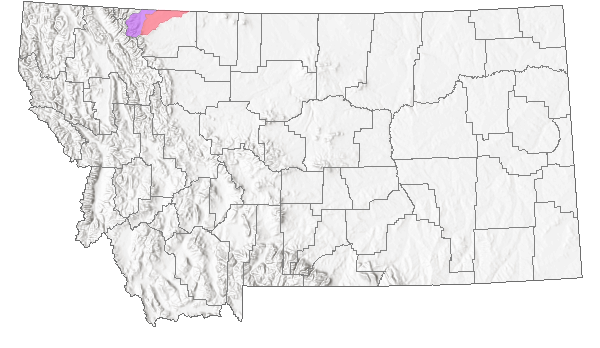 Western Hemisphere Range
Western Hemisphere Range
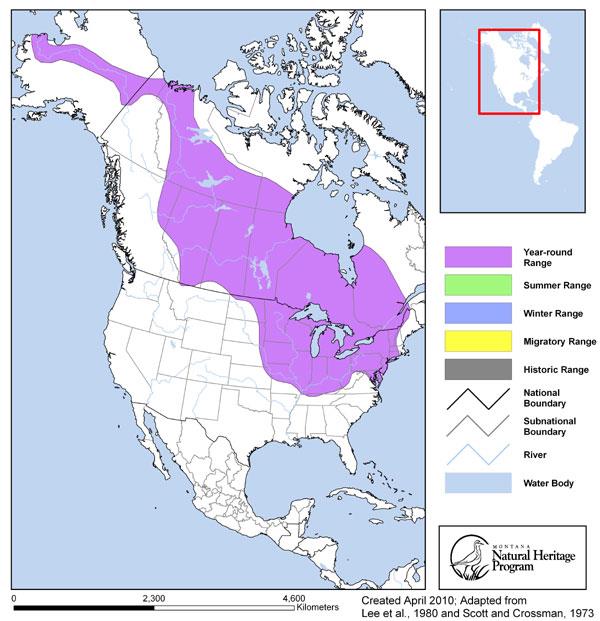
Range Comments
The range of the trout-perch includes the Ohio, lower Missouri, MacKenzie, Yukon, and Hudson Bay basins, and the central Atlantic slope north to Quebec (Lee et al. 1980). In Montana, the trout-perch occurs in the South Saskatchewan River basin, which drains northeastern Glacier National Park and the northwestern portion of the Blackfeet Indian Reservation. Trout-perch were not reported in Montana until 1968 (Gould 1969), and the only Montana collection records are from Lower St. Mary Lake (Gould 1969; Brown 1971) and the associated St. Mary canal (Holton and Johnson 1996). Trout-perch have not been reported in other areas of the South Saskatchewan River basin in Montana, such as the Belly River and Waterton Lake, but they may occur there, as this basin has not been surveyed extensively.
Observations in Montana Natural Heritage Program Database
Number of Observations: 4
(Click on the following maps and charts to see full sized version)
Map Help and Descriptions
Relative Density
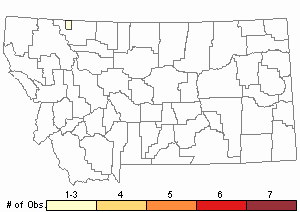
Recency
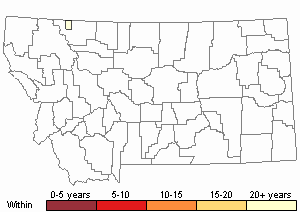
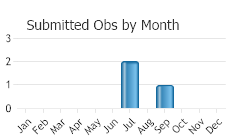
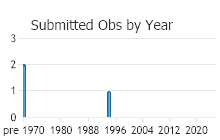
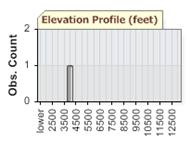 (Observations spanning multiple months or years are excluded from time charts)
(Observations spanning multiple months or years are excluded from time charts)
Migration
Trout-perch are reported to undergo diel migrations into the shallower inshore waters of lakes at night.
Habitat
The preferred habitat of the Trout-perch is along the shoals of lakes or in deeper pools of streams where the bottom is clean sand, gravel, or rubble. They spawn over sand or gravel in 3-4 feet of water. In the Lower Saint Mary Lake, they are associated with large rocky cover, and are not captured over sandy or silty substrates. During daylight periods, they appear to use rocks as hiding cover, while at night, they are out of, but in close proximity to, rocky cover. In the Saint Mary Canal, Trout-perch have been captured in winter after the canal head gate is closed. In the canal, Trout-perch are found in residual pools, associated with large, rocky cover or concrete rip-rap (R. Wagner, USFWS, personal communication, October 2000,
Montana AFS Species Status Account).
Food Habits
The species feeds mostly on aquatic insects and crustaceans. Some small fishes are also eaten.
Ecology
The life span of Trout-perch is three to four years (Magnuson and Smith 1963). Trout-perch are reported to undergo diel migrations into the shallower inshore waters of lakes at night (Brown 1971, Eddy and Underhill 1974, Becker 1983, Nelson and Paetz 1992). It is an important forage item for game fish such as Walleye and Northern Pike (Magnuson and Smith 1963, Scott and Crossman 1973,
Montana AFS Species Status Account).
Reproductive Characteristics
The limited information available indicates that they become sexually mature in one to three years, and spawn from May to August in shallow waters of both lakes and streams (Magnuson and Smith 1963, Scott and Crossman 1973, Nelson and Paetz 1992). Eggs are adhesive and hatch in about 6 days at 20 to 23 degrees C. (Magnuson and Smith 1963,
Montana AFS Species Status Account).
Management
Trout-perch are classified as a non-game wildlife species by Montana Fish, Wildlife and Parks. They are too small to be sought by anglers. The entire known range of Trout-perch in Montana is within Glacier National Park and the Blackfeet Indian Reservation. Neither entity has a specific management program for Trout-perch. Surveys in the Belly River and Waterton Lake in Montana are needed to establish the presence of Trout-perch in these waters (
Montana AFS Species Status Account).
Stewardship Responsibility
Threats or Limiting Factors
Trout-perch may be sensitive to warming water temperatures, because summer die-offs have been reported for some Minnesota lakes (Eddy and Underhill 1974). In Alberta, a marked decline in trout-perch has occurred in the Red Deer River, probably due to the effects of a dam built there (J. S. Nelson, University of Alberta, personal communication, October 2000). In Lower Saint Mary Lake, Montana, some trout-perch are lost to the population when they enter the Saint Mary Canal.
References
- Literature Cited AboveLegend:
 View Online Publication
View Online Publication Becker, G. C. 1983. Fishes of Wisconsin. University of Wisconsin Press, Madison. 1052 pp.
Becker, G. C. 1983. Fishes of Wisconsin. University of Wisconsin Press, Madison. 1052 pp. Brown, C.J.D. 1971. Fishes of Montana. Bozeman, MT: Big Sky Books/Montana State University. 207 p.
Brown, C.J.D. 1971. Fishes of Montana. Bozeman, MT: Big Sky Books/Montana State University. 207 p. Eddy, S. and J. C. Underhill. 1974. Northern fishes. University of Minnesota Press, Minneapolis. 414 pp.
Eddy, S. and J. C. Underhill. 1974. Northern fishes. University of Minnesota Press, Minneapolis. 414 pp. Lee, D.S., C.R. Gilbert, C.H. Hocutt, R.E. Jenkins, D. E. McAllister, J. R. Stauffer, Jr. 1980. Atlas of North American freshwater fishes. North Carolina State Musuem of Natural History. 867 p.
Lee, D.S., C.R. Gilbert, C.H. Hocutt, R.E. Jenkins, D. E. McAllister, J. R. Stauffer, Jr. 1980. Atlas of North American freshwater fishes. North Carolina State Musuem of Natural History. 867 p. Magnuson, J. J. and L. L. Smith, Jr. 1963. Some phases of the life history of the trout-perch, Percopsis omiscomaycus. Ecology 44(1):83-95.
Magnuson, J. J. and L. L. Smith, Jr. 1963. Some phases of the life history of the trout-perch, Percopsis omiscomaycus. Ecology 44(1):83-95. Montana Chapter of the American Fisheries Society species status accounts.
Montana Chapter of the American Fisheries Society species status accounts. Nelson, J. S. and M. J. Paetz. 1992. The fishes of Alberta. Second edition. The University of Alberta Press, Edmonton, and The University of Calgary Press.
Nelson, J. S. and M. J. Paetz. 1992. The fishes of Alberta. Second edition. The University of Alberta Press, Edmonton, and The University of Calgary Press. Scott, W.B. and E.J. Crossman. 1973. Rainbow trout, Kamloops trout, Steelhead trout Salmo gairdneri Richardson. pp. 184-191. In: Freshwater fishes of Canada. Ottawa, Canada: Fisheries Research Board of Canada, Bulletin 184. 966 p.
Scott, W.B. and E.J. Crossman. 1973. Rainbow trout, Kamloops trout, Steelhead trout Salmo gairdneri Richardson. pp. 184-191. In: Freshwater fishes of Canada. Ottawa, Canada: Fisheries Research Board of Canada, Bulletin 184. 966 p.
- Additional ReferencesLegend:
 View Online Publication
View Online Publication
Do you know of a citation we're missing? Joslin, Gayle, and Heidi B. Youmans. 1999. Effects of recreation on Rocky Mountain wildlife: a review for Montana. [Montana]: Montana Chapter of the Wildlife Society.
Joslin, Gayle, and Heidi B. Youmans. 1999. Effects of recreation on Rocky Mountain wildlife: a review for Montana. [Montana]: Montana Chapter of the Wildlife Society.
- Web Search Engines for Articles on "Trout-perch"
- Additional Sources of Information Related to "Fish"





